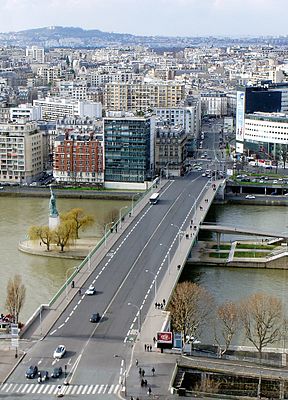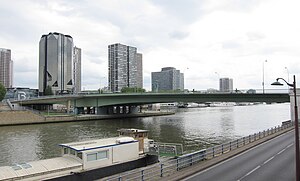Pont de Grenelle
Coordinates: 48 ° 51 ′ 1 ″ N , 2 ° 16 ′ 48 ″ E
| Pont de Grenelle | ||
|---|---|---|
| use | Road bridge | |
| Crossing of | His | |
| place | Paris | |
| construction | Solid wall beam | |
| overall length | 220 m | |
| width | 30 m | |
| Number of openings | five | |
| Longest span | 2 × 85 m | |
| start of building | 1966 | |
| completion | 1968 | |
| location | ||
|
|
||
The Pont de Grenelle is a road bridge in Paris over the Seine and the Île aux Cygnes (Swan Island ) , which was raised in 1825 for bridge construction and divides the river here into two arms.
Location
The bridge near the Maison de Radio France is one of several connections between the 15th and 16th arrondissements . Like two other bridges, it is supported in the middle of the river on the island of Île aux Cygnes and is number 34 of the 37 Seine bridges within Paris in the direction of flow.
Description of the current structure
The total of 220 m long bridge has a 22 m wide carriageway and two 4 m wide walkways. A lane for buses and cyclists and the center line are marked on both sides of the road. You can drive in three lanes on each of the unmarked directional lanes. The entire width of the northern bridge ramp cannot be used, however, as the building on Rue Maurice Bourdet n ° 5 blocks a lane and the sidewalk and traffic are diverted around the building. From the middle of the bridge, a 34 m long footbridge leads down to the island parallel to the direction of the river.
The supporting structure consists of seven parallel steel solid wall girders , the middle sections of which are supported on two rows of concrete pillars that are 20 m apart on the Île aux Cygnes. Above the two arms of the river, the girders form cantilever arms with spans of 85 m each. The girders end on 15 m long concrete bridges with openings for traffic in the port area or on the Voie Georges Pompidou expressway on the right bank .
The little statue of liberty
On the western tip of the Île aux Cygnes is a model of the Statue of Liberty created by Frédéric-Auguste Bartholdi and inaugurated in New York in 1886 . The post-revolutionary title of the statue (1789) and since then also in France repeatedly influenced by the debate about human rights is: La Liberté éclairant le monde (German: Freedom, illuminating the world). The 11.5 m high and 14 t heavy bronze statue is a 1: 4 scale cast of the plaster model that Bartholdi created in preparation for his main work. The cast of the model was given to France by Americans residing in Paris as Colonie Parisienne as a thank you and inaugurated on July 4, 1889 on the anniversary of the United States' declaration of independence by President Sadi Carnot and the American Ambassador Whitelaw-Reid.
At that time she was standing with a view over the bridge towards downtown Paris, contrary to Bartholdi's idea that she had to face west, towards the United States. Only on the occasion of the Paris World Exhibition of 1937 was it turned around in the virtual viewing direction to its four times as high counterpart in New York harbor , in accordance with Bartholdi's wishes .
history
The first bridge was opened in 1827. At that time, the wooden bridge on masonry pillars was still outside Paris and connected the newly built Nouveau Village de Grenelle with the still independent municipality of Passy . It should also facilitate long-distance traffic. The tolls ranged from 1 centime for pigs, sheep or goats, 2 centimes for donkeys, 5 centimes for cattle and pedestrians, 10 centimes for riders, 15 centimes for one-horse carriages to 25 cents for two-horse carriages.
Second structure: In 1874 a cast iron bridge with three arches each was opened over the two arms of the river, as the old bridge was no longer able to cope with the increased traffic. In addition, a place was set up for the planned installation of the Statue of Liberty.
As early as the beginning of the 20th century it became clear that the bridge was no longer able to cope with the increased traffic on both the road and the river. When signs of corrosion and cracks appeared in the middle of the century, it was decided to build a new building. In the years 1966 to 1968, the current third bridge was built on this site according to the plans of the engineers Thenault, Grattesat and Pilon, which crosses the river arms without piers disturbing ship traffic.
Web links
Individual evidence
- ↑ a b c d Pont de Grenelle. On Planète TP, September 24, 2007, accessed July 10, 2016 (French).
- ↑ Barry Moreno: The Statue of Liberty Encyclopedia. Simon & Schuster, New York 2000, ISBN 0684862271 , pp. 200-201.
- ^ Statue de la Liberté à Grenelle . On Paris-1900, March 11, 2011, accessed July 10, 2016 (French).
- ↑ Affiche indiquant les droits de péage sur le nouveau pont de Grenelle ouvert aux piétons le 1er may 1827 avec l'indication sur le plan des voies à suivre pour y parvenir (announcement of the tolls of the new bridge of Grenelle with map) . ( Digitized on Gallica ).



